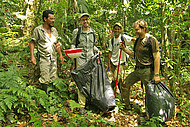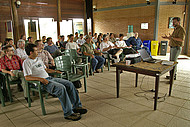SOLOBIOMA
Bodenbiota und Biogeochemie in Küstenregenwäldern Südbrasiliens. Beurteilung der ökosystemaren Qualität von Sekundärwäldern und ihres Potentials zum Schutz der Biodiversität
Das Verbundprojekt SOLOBIOMA ist ein Beispiel für bilaterale Forschung vor dem Hintergrund des Übereinkommens über die biologische Vielfalt (Convention on Biological Diversity CBD). Es wurde von 2003 bis 2010 durch das deutsche Bundesministerium für Bildung und Forschung (BMBF) und den brasilianischen Forschungsrat (CNPq) gefördert. Das Akronym SOLOBIOMA leitet sich aus dem portugiesischen Projekttitel 'Biota de SOLO e BIOgeoquímica na MAta Atlântica do Paraná' ab. Das Projekt wurde von der tropenökologischen Arbeitsgruppe des Naturkundemuseums Karlsruhe (Dr. Höfer, Dr. Verhaagh) koordiniert. Deutsche Partner waren Tierökologen der Universität Marburg, Umweltbiologen der Technischen Hochschule Aachen und Umweltanalytiker der ECT Ökotoxikologie GmbH in Flörsheim am Main. Brasilianische Partner waren Bodenkundler der Staatlichen Universität von Paraná (UFPR) in Curitiba sowie ein brasilianischer "stakeholder", die Nicht-Regierungsorganisation SPVS (Forschungsgesellschaft für Wildtiere und Umwelterziehung). Weitere Informationen zum Projekt InBioVeritas, der Metadatenbank zu Studien in der südlichen Mata Atlântica. Video zu den Arbeiten des Projekts Solobioma. Eine Zusammenfassung der Ergebnisse ist in Procedia Environmental Sciences publiziert (Höfer et al. 2011).Ausgewählte Publikationen
- Raub F., Höfer H., Scheuermann L. (2017):
- Data Papers: Spider (Arachnida, Araneae) diversity in secondary and old-growth southern Atlantic forests of Paraná state, Brazil. Ecology 98: DOI: 10.1002/ecy.1854
- Martins K.G., Marques M.C.M., dos Santos E. & Marques R. (2015):
- Effects of soil conditions on the diversity of tropical forests across a successional gradient. Forest Ecology and Management 349: 4-11
- Raub F., Höfer H., Scheuermann L., de Britez R.M. & Brandl R. (2015):
- Conserving landscape structure – conclusions from partitioning of spider diversity in southern Atlantic forests of Brazil. Studies of Neotropical Fauna and Environment 50: 158-174
- Römbke J.,Collado R., Höfer H., Ottermanns R., Raub F., Roß-Nickoll M. & Schmelz R. (2015):
-
Species diversity of Enchytraeidae (Oligochaeta) in pastures, regenerating secondary forests, and old-growth forests in the southern Mata Atlântica (Brazil).
Soil Organisms 87(2): 101-120

- Raub F., Höfer H., Scheuermann L., Brandl R. (2014):
-
The conservation value of secondary forests in the southern Brazilian Mata Atlântica from a spider perspective.
Journal of Arachnology 42: 52-73

- Raub F., Scheuermann L., Höfer H., Brandl R. (2014):
- No bottom-up effects of food addition on predators in a tropical forest. Basic and Applied Ecology 15: 59-65
- Zwiener V.P. , Cardoso F.C.G., Padial A.A., Marques M.C.M. (2014):
- Disentangling the effects of facilitation on restoration of the Atlantic Forest. Basic and Applied Ecology 15: 34-41
- Dickow KMC., Marques R., Pinto CB., Höfer H. (2012):
-
Produção de serapilheira em diferentes fases sucessionais de uma floresta subtropical secundária, em Antonina, PR.
Cerne 18: 75-86

- Moser T., Förster B., Frankenbach S., Marques R., Römbke J., Schmidt P., Höfer H. (2012):
-
Nematode assemblages of banana (Musa acuminata) monocultures and banana plantations with Juçara palms (Euterpe edulis) in the southern Mata Atlântica, Brazil.
Nematology 14: 371-384

- Gießelmann U.C., Geronazzo Martins K., Brändle M., Schädler M., Marques R., Brandl R. (2011):
- Lack of home-field advantage in the decomposition of leaf litter in the Atlantic Rainforest of Brazil. Applied Soil Ecology 49: 5-10
- Höfer H., Bihn JH., Borges C., Britez RMd., Brandl R., Fabry R., Jetzkowitz J., Kahle HP., Marques R., Ottermanns R., Paulsch D., Römbke J., Roß-Nickoll M., Verhaagh M. (2011):
-
InBioVeritas – Valuating nature in the southern Mata Atlântica of Brazil.
Procedia Environmental Sciences 9: 64-71

- Hopp P.W., Caron E., Ottermanns R., Roß-Nickoll M. (2011):
- Evaluating leaf litter beetle data sampled by Winkler extraction from Atlantic forest sites in southern Brazil. Revista Brasileira de Entomologia 55(2): 253-266
- Ottermanns R., Hopp P.W.,Guschal M., Pacheco das Santos G., Meyer S., Roß-Nickoll M. (2011):
- Causal relationship between litter beetle communities and regeneration patterns of vegetation in the Atlantic rainforest of Southern Brazil (Mata Atlântica). Ecological Complexity 8: 299-309
- Bihn J.H., Gebauer G., Brandl R. (2010):
- Loss of functional diversity of ant assemblages in secondary tropical forrests. Ecology 91(3): 782-792
- Fabry R., Höfer H. & Marques R. (Hrsg.) (2010):
- SOLOBIOMA - A Mata Atlântica no Paraná, sua vida, seu futuro. Herausgegeben von: InBioVeritas, Curitiba : 1-35
- Giesselmann UC., Martins KG., Brändle M., Schädler M., Marques R., Brandl R. (2010):
- Diversity and ecosystem functioning: Litter decomposition dynamics in the Atlantic Rainforest. Applied Soil Ecology 46: 283-290
- Hopp P.W., Ottermanns R., Caron E., Meyer S., Roß-Nickoll M. (2010):
- Recovery of litter inhabiting beetle assemblages during forest regeneration in the Atlantic forest of Southern Brazil. Insect Conservation and Diversity 3: 103-113
- Höfer H., Ott R. (2009):
-
Estimating biomass of Neotropical spiders and other arachnids (Araneae, Opiliones, Pseudoscorpiones, Ricinulei) by mass-length regressions.
Journal of Arachnology 37: 160-169

- Römbke J., Schmidt P., Höfer H. (2009):
-
The earthworm fauna of regenerating forests and anthropogenic habitats in the coastal region of Paraná.
PAB (Pesquisa Agropecuária Brasileira) 44: 1040-1049

- Bihn JH., Verhaagh M., Brandl R. (2008):
- Ecological stoichiometry along a gradient of forest succession: bait preferences of litter ants. Biotropica 40: 597-599
- Bihn JH., Verhaagh M., Brändle M., Brandl R. (2008):
- Do secondary forests act as refuges for old growth forest animals? Recovery of ant diversity in the Atlantic forest of Brazil. Biological Conservation 141: 733-743
- Liebsch D., Marques M.C.M., Goldenberg R. (2008):
- How long does the Atlantic Rain Forest take to recover after a disturbance? Changes in species composition and ecological features during secondary succession. Biological Conservation 141: 1717-1725
- Schmidt P., Dickow K., Rocha AA., Marques R., Scheuermann L., Römbke J., Förster B., Höfer H. (2008):
-
Soil macrofauna and decomposition rates in southern Brazilian Atlantic rainforests.
Ecotropica 14: 89-100

- Rocha AA., Schmidt P., Dickow KMC., Marques R., Höfer H. (2007):
- Decomposição foliar de Tibouchina pulchra Cogn. em tipologias da Floresta Ombrófila Densa no Paraná. XXXI Congresso Brasileiro de Ciência do Solo, Gramado, Brasilien : 1-4
- Rocha Ferretti A., Miranda de Britez R. (2006):
- Ecological restoration, carbon sequestration and biodiversity conservation: the experience of the Society for Wildlife Research and Environmental Education (SPVS) in the Atlantic Rainforest of Southern Brazil. Journal for Nature Conservation 14: 249-259
Liste der Mitarbeiter

Dr. Hubert Höfer, Dipl.-Biol.
Telefon: +49 721 175 2826
E-Mail: hubert.hoefer[at]smnk.de

Dr. Florian Raub, Dipl.-Biol.
Telefon: +49 721 175 2820
E-Mail: florian.raub[at]smnk.de

Dr. Manfred Verhaagh, Dipl.-Biol.
Telefon: +49 721 175-2835
E-Mail: manfred.verhaagh@smnk.de








